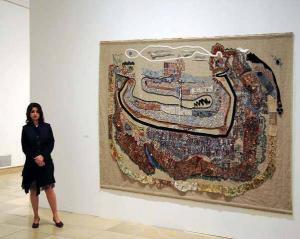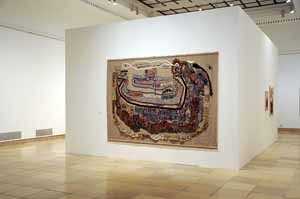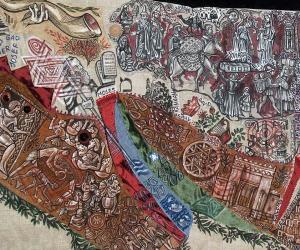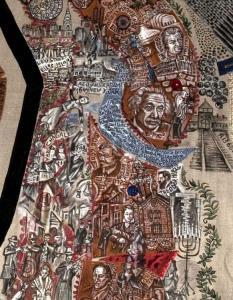
Living in the shtetl – small town communities in Eastern Europe. Marc Chagall. Levi Strauss. Ellis Island, New York. Synagogue in Worms, 1034. Synagogue “Staranova” in Prague, at 1300. Maimonides – The most important Jewish scholar of the Middle Ages. Kronacher Synagogue. Scholem Aleichem (1859-1916) – writer (“Fiddler”). Theodor Herzl (1860-1904). Shoah. Albert Einstein. Golda Meir-The first prime Minister of Israel. Map of Israel. Eliezer Ben Yehuda author of the first Modern Hebrew dictionary.
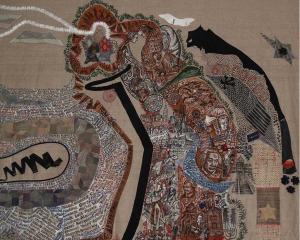
Family car: Memories of the grandparents and the childhood of the artist in Odessa. Writing on Wheels: Cities in Eastern Europe. The motifs of the Garden of Eden (upper left) are repeated in the desired home (worldly arrival). Middle of the picture, above: Names of important personalities of world culture. Black leather strips – prayer belts Tefillin. The motifs of the Garden of Eden repeat themselves in the desired home in the middle (spiritual arrival). The circle closes.
The Eternal Trek of Jewish History
The exploration of one’s own identity is a fundamental subject of art history, which in a society that is shaped by the idea of globalization is constantly gaining importance. The awareness of being part of a cultural group that can look back on a history of over 3.000 years has a connecting effect and confirms one’s identity.
The collage “The eternal trek of Jewish history” attempts to translate this history into its entirety into an individual visual language. The large-sized textile collage shows important milestones of Jewish history from its beginning until today, from its dispersion in the diaspora up to the 21st century. Key moments from historic incidents, from rites and traditions are cited kaleidoscopically and interpreted artistically in the style of the individual epochs.
Names and portraits of important figures of our global culture from the arts, music, literature, philosophy and religion, the sciences and technology are fused to extensive image-units that can be experienced as abstract play of forms – or can be deciphered as informative flow of image and text.
Quotations, illustrations and interpretations conjoin through the sensitive employment of various elements of style and by using different levels of abstraction, which are precisely harmonized and complement each other to form a great narrative-aesthetical unity, which manages to purvey a concentrated formal consolidation and consistent continuity of Jewish history.
The base of the collage is a coarse linen fabric as symbol for the formation of the world. Fabric or leather strips guide and accompany the observer’s glance through the graphic-pictorially illustrated episodes of Jewish history and are organized in such a way that they consciously or subconsciously remind of religious symbols. Leather strips in red or terracotta symbolize the historic habitat of the Sinai Desert, those in black symbolize the tallit and the tefelin. The knotted cords in the middle of the work quote the fringes of the prayer robe. They represent the unity of the Jewish people and the five knots remind us of the five books of Moses.
Flowered strips of jacquard fabric, which have been sewn together, symbolize the mundane business of everyday life, while those with geometrical patterns recall spiritual Judaism, preserving and teaching traditions. The motif of the flowered jacquard fabric, whose pattern is inspired by the idea of the Garden Eden (top left) as allegory for a fulfilling religious life, is repeated in the dream of the desired earthly home (top right) and in the place of spiritual advent (middle). The longing for a home, which is present throughout the entire history of the people of Israel, is central for the collage and symbolizes the beginning as well as the end of the earthly journey, but also the aspect of infinity.
Here we come full circle and the viewer’s gaze is directed towards the general concept. In short individual episodes, the collage narrates details of the manifold history without ever letting out of sight the big overall picture. The general composition of the collage seems to take the shape of Noah’s Ark. Thus “The Eternal Train of Jewish History” turns into a ship in movement, which, starting from the Garden Eden, eternally sails the seas and oceans in search for the new home.
The observer may delve deeply into the visually dense artistic description, which is rich in experiences and content and become lost in the precise montage of images from a multiplicity of historic incidents that complement one another to a logical interlocking narration. The technique of the material collage, though, with its play of coarse and fine, harmonious and destroyed structures, graphically emphasizes the work’s materiality and thereby its relation to reality, demonstrating impressively the collective fate of the Jewish people within the bigger context of world history, as well as the importance and meaning of the individual members of the Jewish community.
Dr. Kerstin F. M. Blum (Komparatistik, Italienisch, Englisch) Otto-Friedrich-Universität Bamberg/University of South Carolina

